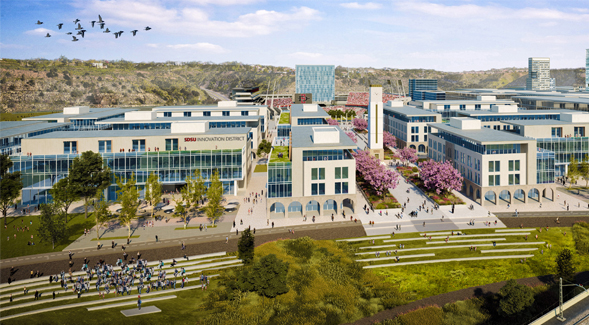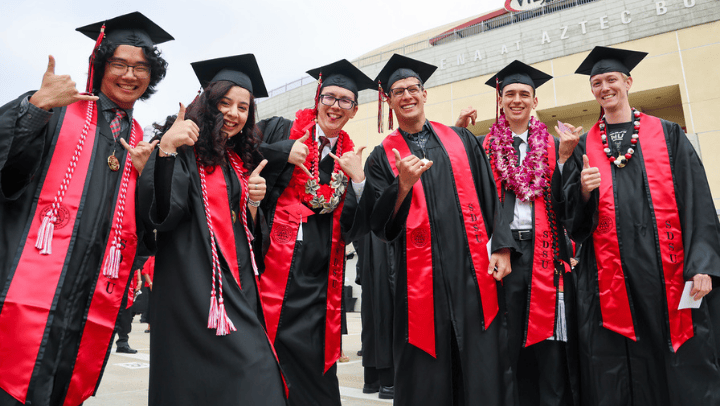Transportation Improvements Part of Proposed SDSU Mission Valley Plan
The Draft EIR released by SDSU proposes mitigation efforts for traffic impacts around the Mission Valley project site.

San Diego State University is proposing more than one dozen off-site and on-site traffic improvements as part of the proposed SDSU Mission Valley project, which are designed to help mitigate traffic generated by the campus expansion. SDSU has also put forward a variety of transportation demand management (TDM) measures, each of which is part of SDSU’s ongoing commitment to sustainability and reducing the university’s carbon footprint. “SDSU is designing a transit-oriented project that aims to get people out of their vehicles and encourages alternative and active modes of transportation,” said Tom McCarron, senior vice president for SDSU Mission Valley Development. “Traffic improvements will also help improve circulation in the area and mitigate potential impacts created by the proposed project.” Among the measures designed to mitigate traffic impacts and increase non-vehicular travel to and from the proposed new campus include:
- Promoting and encouraging the use of alternative modes of transportation, including the trolley.
- Providing preferential parking and varying parking rates for carpools and zero-emission vehicles.
- Access to support for bicycle commuters, including bicycle parking spaces, valets, fix-it stations and commuter showers and lockers.
More than four miles of hike and bike trails are integrated into the proposed project, including connections to the San Diego River Trail system.
Transportation Demand Management Measures
The proposed project’s mix of land uses, including residential, retail, educational and parks, provide future residents with nearby access to basic services and shopping, employment and recreation opportunities without having to travel outside of the project site. The university residential development will also feature unbundled residential parking and no parking minimums, consistent with the city’s new transit-oriented parking policies. TDM measures are also designed to enhance the usage of the MTS Trolley Green Line, which stops on the site and at stations just east and west of the site. SDSU is designing an enhanced trolley plaza to provide for access to retail and recreational uses within walking distance of the existing station. While event traffic is expected to decrease from existing levels due to the smaller stadium capacity, day-to-day traffic is expected to increase as the campus is developed over time. If provided with the opportunity to purchase the Mission Valley site, SDSU will implement and/or fund its share of several off-site and major on-site traffic improvements at the project site and on surrounding roadways. Proposed project features would enhance connectivity to the site at new permanent access points at the southern edges of the site, providing for a new connection from Fenton Parkway and a permanent connection off Rancho Mission Road. Proposed projects include the realignment of Friars Road at Stadium Way with the installation of a new full-time traffic signal, new turn lanes, the extension of bike lanes and enhanced pedestrian safety features. Another major improvement includes the widening of the bridge over Friars Road and all four interchange ramps at Mission Village Drive, as well as the extension of protected bike lanes and sidewalks into the campus site. Additional traffic mitigation includes widening and restriping of San Diego Mission Road at Fairmount Avenue and a number of traffic signal optimization projects to help traffic flow more freely.
Proposed off-site traffic improvements are meant to mitigate potential traffic generated by the project and will be completed, or the university’s fair share obligation will be funded, at the points when actual campus land uses cause certain significant impacts under the California Environmental Quality Act (CEQA). Significant impacts occur when development causes projected additional daily trips that increase traffic levels above acceptable thresholds. These thresholds will be identified in the Final EIR’s Mitigation Monitoring Plan, which will make the proposed traffic improvements and their timing binding on the CSU.
Draft EIR Process
The Draft EIR’s proposed traffic improvements for City streets and intersections are subject to the CSU Board of Trustees’ approval and EIR certification, the City’s cooperative agreement as to the proposed off-site traffic improvements and costs, completion of a purchase and sale agreement with the City of San Diego, and the occurrence of a significant impact is identified in the Final EIR’s Mitigation Monitoring Plan and triggered by actual development, and coordination with the City on the specific traffic improvement.
The Draft EIR is available for review for an extended period of 60 days on the SDSU Mission Valley website. The public comment period is open and will close on Thursday, Oct. 3. During the public comment period, SDSU expects to receive, consider and respond to public input on its traffic analysis, and on all other portions of the Draft EIR. SDSU kicks off the first of three public meetings on Thursday, Sept. 12, to provide the public with opportunities to review the proposed Draft EIR findings and speak with the SDSU Mission Valley team. Meetings are open to the campus community and members of the public at the following times and locations:
- Thursday, Sept. 12, noon to 1:30 p.m., at SDSU’s Parma Payne Goodall Alumni Center, 5250 55th St., in San Diego. A parking garage is located just south of the building.
- Thursday, Sept. 12, 5:30 p.m. to 7 p.m., at SDSU’s Parma Payne Goodall Alumni Center, 5250 55th St., in San Diego. A parking garage is located just south of the building.
- Tuesday, Sept. 24, 5:30 p.m. to 7 p.m., at the Mission Valley Marriott, 8757 Rio San Diego Dr., in San Diego.
SDSU plans to present the Final EIR to the CSU Board of Trustees in early 2020 with plans to initiate construction shortly thereafter.
More information is available online, via the SDSU Mission Valley site.



